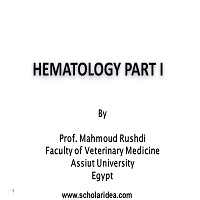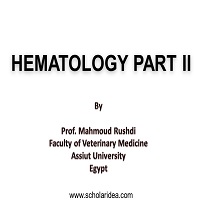All parameters of the erythrocyte picture can be determined using a blood cell counter, except assessing the morphological appearance of the RBCs, which must be evaluated using blood smear. This means, that both electronic blood cell count and blood smear are required to perform the erythrocyte picture.
Morphological examination of erythrocytes is carried out by examination of a stained blood film (Giemsa stain) under the light microscope using the oil immersion lens (X100), the RBCs are examined for shape, size, stain and inclusion bodies.
The normal shape of the RBCs is different between animal species, it is oval in shape in birds, oval and nucleated in camels, rounded, biconcave disc shape in other animal species. RBCs of some animal species tend to adhere to each other to form a network (Rouleux formation), which is mostly apparent in equines and to some degree in buffaloes.
Size:
The size of the RBCs also varies between different animal species. Goats and sheep have the smallest RBCs (3-4µ, diameter), the diameter of other animal species’ RBCs vary between 5-7µ.
Stain:
Hemoglobin is the red pigment that contained inside the RBCs, and give the characteristic red color to the erythrocytes. In stained blood smear, normally, the color of the RBCs is homogenous.
Inclusion bodies:
The mature RBCs that circulate in the blood stream has no nucleus and no inclusion bodies. The presence of inclusion bodies is abnormal. Morphological examination of RBCs in a stained blood smear is very important and give a full erythrocyte picture together with the quantitative analysis. Any abnormal findings during microscopical examination of RBCs must be recorded.
Morphological examination of erythrocytes is very important because it can help with interpretation of the abnormal findings that may emerge after the quantitative analysis. For example, the presence of reticulocytes or macrocytic erythrocytes during the morphological analysis can help with interpretation of higher MCV. Also, the morphological analysis can be diagnostic, for example the detection of intracellular parasites, is a diagnostic and can help with interpretation of abnormal erythrocyte counts.






